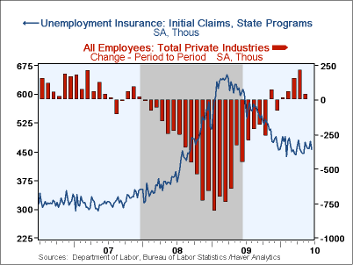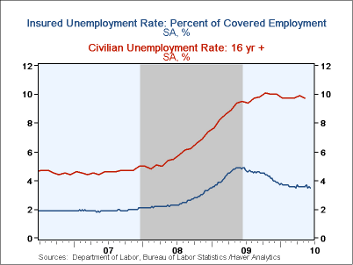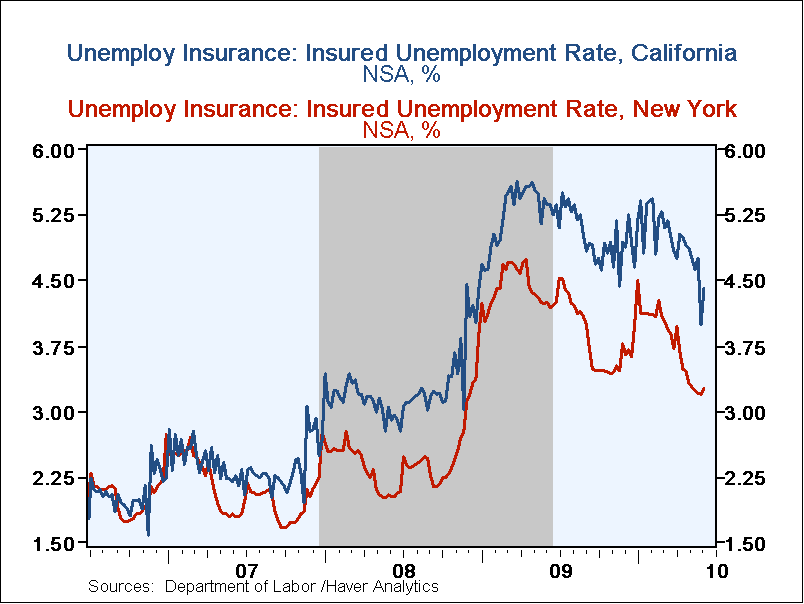 Global| Jun 24 2010
Global| Jun 24 2010U.S. Initial Jobless Insurance Claims Slip & Continue Sideways Trend
by:Tom Moeller
|in:Economy in Brief
Summary
Volatility around a sideways trend continued as the pattern, since December, for initial claims for unemployment insurance. Claims fell 19,000 last week to 457,000 following a 17,000 gain during the prior week. Consensus expectations [...]
 Volatility around a sideways trend continued as the pattern, since
December, for initial claims for unemployment insurance. Claims fell
19,000 last week to 457,000 following a 17,000 gain during the prior
week. Consensus expectations were for 460,000 claims. Last week's figure
was down from the recession peak of 651,000 reached in March of 2009.
The four-week moving average of initial claims fell slightly to 462,750.
Volatility around a sideways trend continued as the pattern, since
December, for initial claims for unemployment insurance. Claims fell
19,000 last week to 457,000 following a 17,000 gain during the prior
week. Consensus expectations were for 460,000 claims. Last week's figure
was down from the recession peak of 651,000 reached in March of 2009.
The four-week moving average of initial claims fell slightly to 462,750.
Continuing claims for unemployment insurance during the latest week fell 45,000 and reversed roughly half of the prior week's increase. Claims were down by one-third from the June '09 peak and remained near the lowest level since December of 2008. The overall decline is a function of the improved job market but also reflects the exhaustion of 26 weeks of unemployment benefits. The four-week average of continuing claims slipped to 4.587M, a new cycle low. This series dates back to 1966.
Ongoing claims do not reflect those who receive extended benefits. Extended benefits for unemployment insurance surged during the latest week to 563,236 and it was the highest level since October. These figures do not include the 4,733,012 benefit recipients (+90.0% y/y) under state administered "EUC" emergency programs, but paid for by the Federal government.
The insured unemployment rate slipped to 3.5%. It reached a high of 4.9% during May of 2009. During the last ten years, there has been a 96% correlation between the level of the insured unemployment rate and the overall rate of unemployment published by the Bureau of Labor Statistics.
The highest insured unemployment rates in the week ending week ending June 5 were in Puerto Rico (6.3 percent), Oregon (5.2), Alaska (5.1), Nevada (4.5), Pennsylvania (4.5), California (4.4), Wisconsin (4.2), Connecticut (4.1), North Carolina (4.1), and Washington (4.0). The lowest insured unemployment rates were in Virginia (1.8), Texas (2.1), Wyoming (2.3), Tennessee (2.7), Maryland (2.8), Maine (2.8), Ohio (2.9), Georgia (3.0), Florida (3.0) and New York (3.3). These data are not seasonally adjusted but the overall insured unemployment rate is.
The unemployment insurance claims data is available in Haver's WEEKLY database and the state data is in the REGIONW database.
Training or search? evidence and an equilibrium model from the Federal Reserve Bank of Kansas City is available here.
| Unemployment Insurance (000s) | 06/19/10 | 06/12/10 | 06/05/10 | Y/Y | 2009 | 2008 | 2007 |
|---|---|---|---|---|---|---|---|
| Initial Claims | 457 | 476 | 459 | -25.4% | 572 | 419 | 321 |
| Continuing Claims | -- | 4,548 | 4,593 | -29.8 | 5,809 | 3,340 | 2,549 |
| Insured Unemployment Rate (%) | -- | 3.5 | 3.6 | 4.9(6/2009) | 4.4 | 2.5 | 1.9 |
Tom Moeller
AuthorMore in Author Profile »Prior to joining Haver Analytics in 2000, Mr. Moeller worked as the Economist at Chancellor Capital Management from 1985 to 1999. There, he developed comprehensive economic forecasts and interpreted economic data for equity and fixed income portfolio managers. Also at Chancellor, Mr. Moeller worked as an equity analyst and was responsible for researching and rating companies in the economically sensitive automobile and housing industries for investment in Chancellor’s equity portfolio. Prior to joining Chancellor, Mr. Moeller was an Economist at Citibank from 1979 to 1984. He also analyzed pricing behavior in the metals industry for the Council on Wage and Price Stability in Washington, D.C. In 1999, Mr. Moeller received the award for most accurate forecast from the Forecasters' Club of New York. From 1990 to 1992 he was President of the New York Association for Business Economists. Mr. Moeller earned an M.B.A. in Finance from Fordham University, where he graduated in 1987. He holds a Bachelor of Arts in Economics from George Washington University.








